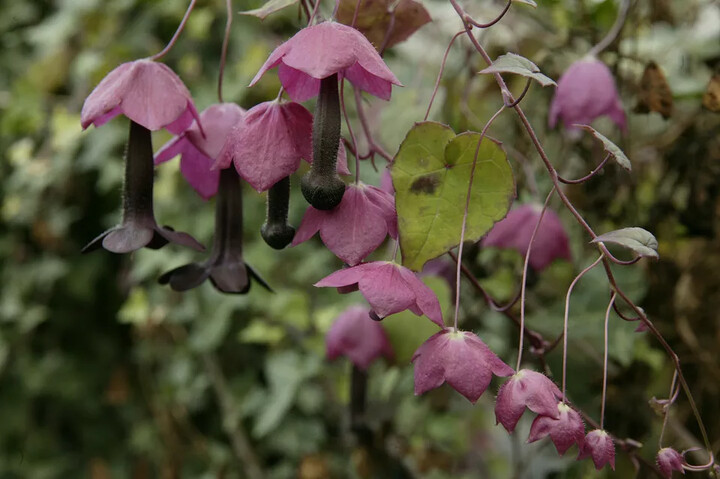
A herbaceous perennial, the rhodochiton is known for its heart-shaped leaves and drooping purple-black, three-inch tubular flowers. They are often referred to as "purple bell vines" and create a gorgeous splash of color thanks to showy blooms that can instantly enhance your outdoor garden's beauty.
These vine-like, climbing plants can grow to a height of about ten feet, and bloom from summer through fall. Indigenous to Mexico, they are commonly grown as a half-hardy annual plant by gardeners.
The rhodochiton is often included in hanging baskets since the plant will gracefully cascade over the edges. You can also plant them in a place that will promote their vertical growth, such as a wall, trellis, or pergola.
Botanical Name :Rhodochiton atrosanguineus
Common Name :Rhodochiton, Purple Bell Vine
Plant Type :Perennial
Mature Size :10 feet
Sun Exposure :Full sun
Soil Type :Humus rich, moist
Soil pH :5.5-6
Bloom Time :Summer/Fall
Flower Color: Purple
Hardiness Zones :9-10
Native Area :Mexico
Rhodochiton Plant Care
When planting outdoors, be sure to wait until after the final frost of the season and space seeds about 10 to 12 inches apart. However, it's generally recommended to start these plants indoors (about five to six weeks before the last frost). The seeds typically take about two to six weeks to germinate.
The rhodochiton is a fast-growing, upward-climbing plant, so it will require some support as it grows. Its twining stems will be adorned with toothed and tinted leaves, with dark green to burgundy coloring around the edges. They will produce blossoms prolifically from the late spring to late fall, and as long as they have the proper support to attach and twine (as well as the proper growing conditions, of course), the vine can grow up to ten feet in just one season.
You can tie the vines to a trellis, lattice, or even a collapsible wooden tepee using string or plant ties in order to prevent the stems from tangling on the ground. Lifted vines will receive better air circulation, which decreases the likelihood of developing a fungal disease.
Light
These plants will grow best when exposed to full sunlight, so you'll want to choose a sunny section of the garden for your rhodochiton plants. However, providing some filtered shade, particularly during hot summer afternoons, can prevent leaf burn.
Water
When first planting the rhodochiton, be sure to water the seeds at least two or three times each week, at least until the overnight temperatures hover consistently above 32 degrees Fahrenheit. After that, you'll have to water your rhodochiton regularly to keep the soil moist and allow the roots to establish properly.
These are plants that grow best in consistently moist soil as a general rule of thumb, it's time to water both outdoor and container-grown plants when the top two inches of soil appears dry.
Soil
Though they can grow in average soil conditions, the rhodochiton will have the best results when planted in humus-rich, moist soil. The soil should also be loamy and fertile, as well as fast draining.
Temperature and Humidity
These plants will thrive in the warmer months and are not hardy below 32 degrees Fahrenheit.
Outdoor vines can survive the winter in USDA zone 9, but the plants will die back completely to the ground. They have to be protected (and if planted in pots, moved indoors) if a particularly cold stretch of weather happens to come during the spring or fall months.
You can provide additional insulation and prevent total dieback by covering the plant's base with a three or four-inch layer of mulch during the winter months.
Fertilizer
To support healthy plant growth, you can fertilize your "purple bell vine" every four weeks using a 10-10-10 water-soluble fertilizer. Start with a rate of half of a teaspoon of fertilizer per one gallon of water.
Propagating Rhodochiton
The rhodochiton can be propagated from cuttings in the spring months.
Pruning
While it won't require extensive pruning, you'll want to trim your rhodochiton after it has bloomed. Trimming the vines back after they've flowered will help encourage lateral branching and create the appearance of bushier plants, while still keeping the vines manageable.
Growing in Containers
When growing in containers, consider using a mixture of two parts sphagnum peat moss, one part loamy soil, and one part perlite for best growth. As it gets larger, the rhodochiton should be moved to larger pots or containers to ensure its continued growth.
Indoor, container-grown rhodochiton plants can be susceptible to aphids, whiteflies, or scale insects, though they can be treated with horticultural oil or insecticidal soap.